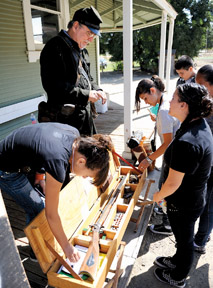After years of disputes over control of the city’s groundwater,
the city, the county, and the San Benito County Water District have
all agreed to work together to manage and improve the city’s
water.
Hollister – After years of disputes over control of the city’s groundwater, the city, the county, and the San Benito County Water District have all agreed to work together to manage and improve the city’s water.
The Hollister City Council Monday became the last of the three groups to sign a Memorandum of Understanding outlining a plan to share control and management of city wells and wastewater.
“These are three groups that weren’t even speaking to each other when I came into office four years ago,” former councilman Brian Conroy said after Monday’s unanimous vote to approve the MOU.
As Councilwoman Pauline Valdivia put it, “This is a big deal.”
Now that the MOU has been approved by all three agencies, it will take effect immediately, according to City Manager Clint Quilter.
The MOU outlines the need for a master plan for Hollister’s water supply and wastewater treatment, Quilter said, and efforts will begin as soon as possible. Once a preliminary work plan is completed, the three groups should have a better idea of how long the master plan will take to draft, said Quilter.
The master plan will be based on a slew of requirements approved in the MOU. Among the provisions, the Hollister Domestic Wastewater Treatment Plant will be the primary treatment plant for the city, the quality of drinking water and wastewater will improve and will be agreed upon by the three agencies, and the plan will support the city’s efforts to get the building moratorium lifted.
“The MOU doesn’t stop the process, it moves it along. What stops it is that if we don’t face the issues and concerns that face the city and the county, then we know the state won’t lift the moratorium,” said former Mayor Tony Bruscia. “If we don’t address the issues and concerns that are beyond the city, then we run a whole lot more risk of not getting the approval of the Regional Water Quality Control Board. What this MOU does is it allows us (the City, County, and SBCWD) to agree about what we’re going to do and put it down in writing.”
As it stands, the MOU does not include the Sunnyslope Water District, but allows it to be included later.
With everyone working together on the MOU, council members are hoping the three-way struggle for power over the city’s groundwater will come to an end.
Quilter and Valdivia said the three agencies have been clashing over the issue for years largely because of a lack of communication and an abundance of other issues popping up.
“I think basically people didn’t really make an effort to do this (work together). We had worked with these entities on other issues and one day we got together and all of a sudden we decided to do this together. Also, I think things just got started in the past and then they fell by the wayside because everyone was so busy,” Valdivia said.
SBCWD Director John Gregg couldn’t be reached for comment.
Now that the three agencies have finally collaborated, they will each be kicking in for the $300,000 proposal. SBCWD will pay $135,000, the City $125,000, and the County $40,000.
Jessica Quandt covers politics for the Free Lance. Reach her at 831-637-5566 ext. 330 or at [email protected].







